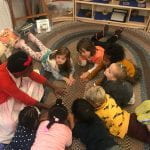Essential Question:
- Who am I and who are the people in my life?
- How does learning about the world around me help me learn more about myself and others?
- For example, how does learning about diversity in nature lend itself to conversations about human diversity?
Overview
How do you get four year olds to slow down and pay attention? In our preschool classroom the answer was to be intentional, get out in nature, and make sure to have lots of fun.
In the beginning of the year, children were asked to slow down and pay attention to the many trees in our school neighborhood. We took time to walk around the block, visit and sketch our “class tree” and notice the other trees in the neighborhood. Instead of just calling it a “tree,” we got specific and called them by their type, maple or a sycamore for example. We felt it was very important to name the trees and introduce the words tree diversity. This was intentional as we would eventually delve more into our own identity and diversity. We read lots of books and made sure that we made an effort to point out how trees can look the same but are actually quite different.
 Children started to slow down and ask questions, “What is this one?” “The leaves are pointy.” “This bark is rough not smooth.” Thinking about trees in this way gave us a great starting point to thinking about ourselves and how people can be both the same and different. This was a great setup to look more in-depth at the parts of trees and what makes each type of tree different and unique. We connected the trees to ourselves as we began to explore what makes us, us. Our skin color, hair, hair texture, our family, the things we like and dislike. At this point we introduced our classroom working definition of identity: who we are, what we are made of, and our story.
Children started to slow down and ask questions, “What is this one?” “The leaves are pointy.” “This bark is rough not smooth.” Thinking about trees in this way gave us a great starting point to thinking about ourselves and how people can be both the same and different. This was a great setup to look more in-depth at the parts of trees and what makes each type of tree different and unique. We connected the trees to ourselves as we began to explore what makes us, us. Our skin color, hair, hair texture, our family, the things we like and dislike. At this point we introduced our classroom working definition of identity: who we are, what we are made of, and our story.
Tori’s Reflective Practice
In November, I read a book to the class entitled, Mixed: A Colorful Story, by Arree Chung. The book is about three colors, red, yellow and blue. These colors live together in harmony until one color thinks that they are better than the others. This issue created such discord that the three colors segregate into different parts of the city. In the end, the colors realize that they create so many beautiful shades and they decide to live in a colorful community together. Without explicitly talking about race, this book powerfully exhibits the ideas of identity, diversity and community. After we finished reading the book, I asked the class what they thought the author was trying to teach the reader. Some of the responses were “To be bright!,” “To live in places with many different colors,” and, “Mixing together is better than being apart.” I wondered if they understood the deeper meaning of this or if they were being literal, as many children are. I struggled to decide whether or not I should leave it up to them to discover a deeper meaning in the story, or if it was best to explicitly make the connection for them that the colors in the book were similar to race. Ultimately, I decided to let them make their own connections independently.

A month later when we introduced Ruby Bridges as a changemaker to our class, I noticed that they were very passionate about the unfairness of Ruby’s fight for equal education. While listening to their reflections, I was reminded aboutthe power of children’s books. I am glad that I let my students come to their own conclusions, rather than think for them. I will continue to be reflective while teaching and question when to step in and when to step back.


Thanks for engaging in this work and supporting our youngest learners. Exploring with the fours about how we move within and between the concrete and the complex is truly challenging as is assessing when to push a bit and when to leave space for discovery. Chung’s book provides an interesting entry point, but also surfaces just how important it is that we help students to understand how the issue of race is made more complicated by issues of power and privilege. At one level, the final decision of the colors to come back together is grounded in a general notion that the colors contribute “equally” in their decision to create a “colorful” community. In seeing the story as a metaphor, we have to wrestle with the complexities of systems that privilege some colors over others and thus has an impact on how the world is then “colored.” In the end, so important that we are guiding the fours into these conversations.
This is an excellent and inspiring read about a classroom where kids thrive. No wonder! I wish I was in your fours class. Thank you for bringing this to the littlest of our students.